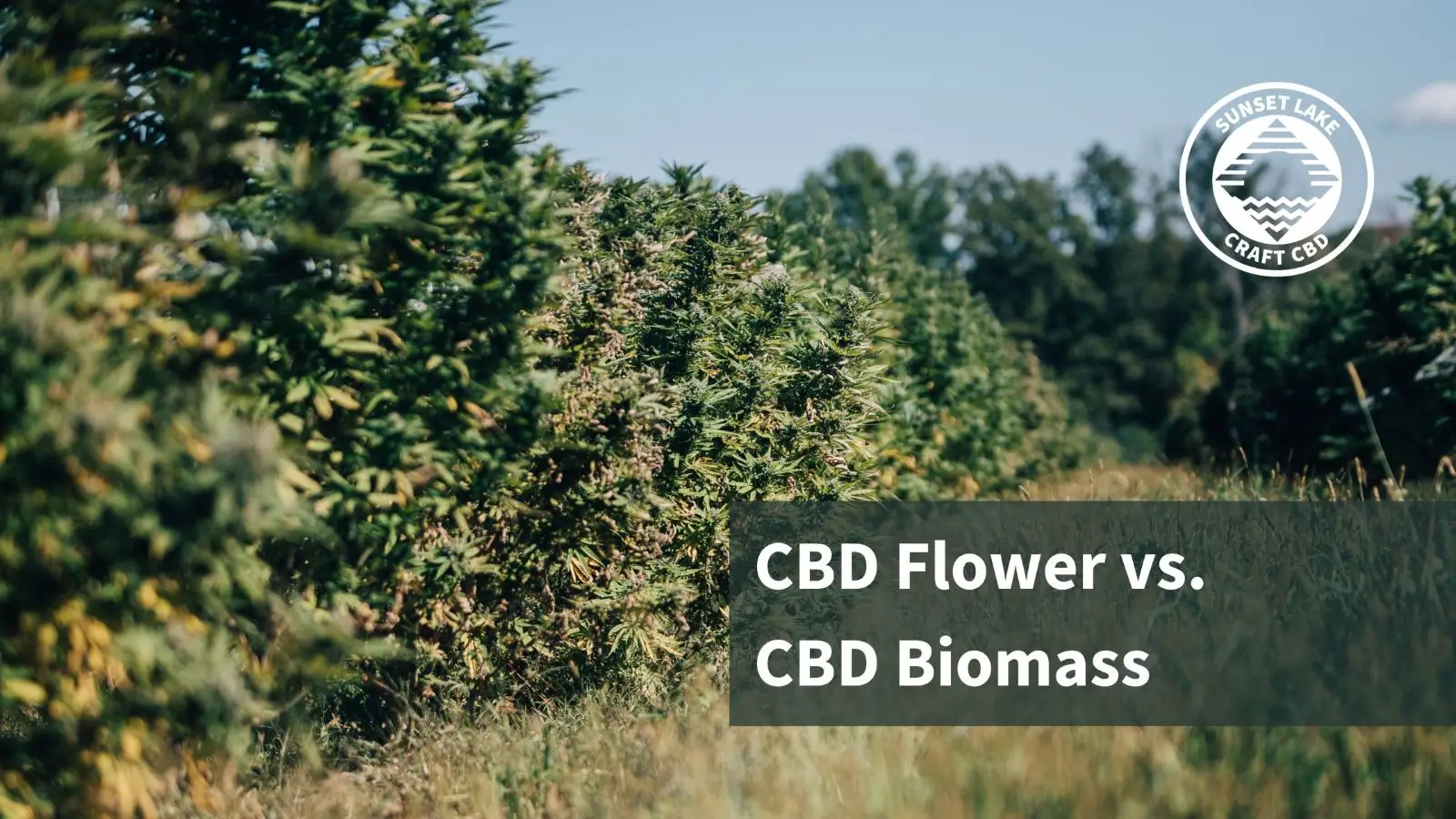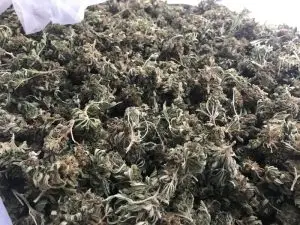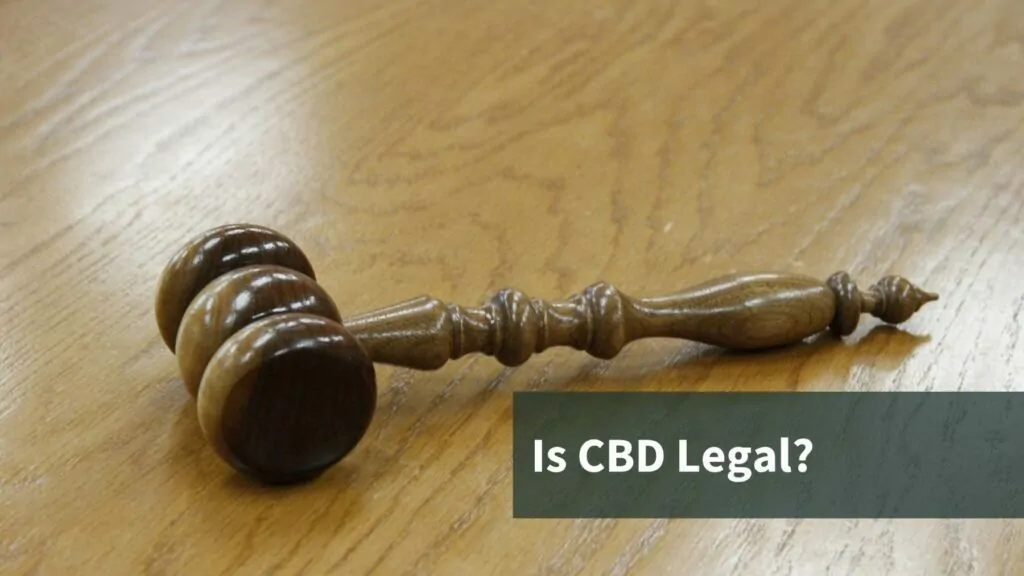No products in the cart.
The Differences Between CBD Flower And CBD Biomass

As the hemp industry grows, new terminology and products hit the market frequently. The deluge can be overwhelming for both new users and oldheads. This post will cover the terms “CBD flower” and “CBD biomass.”
While both come from the same plant, some key differences exist in their appearance, composition, and how we use them.
TL;DR
We extract cannabinoid-rich concentrates from biomass to use in the manufacturing process. Concentrates are easier to infuse into edibles, topicals, and oils than raw CBD flower.
What is CBD Flower?
CBD flower is the bud produced by mature female hemp (Cannabis Sativa L.) plants. Unlike marijuana, a genetically different version of flower, CBD flower contains low levels of THC (less than 0.3%).
CBD flower contains high levels of cannabidiol, better known as CBD, as well as other cannabinoids. Sunset Lake harvests its CBD flower by hand, drying, curing, and trimming it to remove stems and any seeds we may find.
You can consume CBD flower in any number of ways, including smoking, vaping, or infusing it into edibles. Many people prefer consuming CBD flower over other CBD methods because it’s minimally processed and full-spectrum.
What is Biomass?
Biomass is a catchall term for organic material derived from living organisms like plants and animals. With the right systems, it can be used as a renewable energy source; think of heating your home with a wood stove. Those wood chips belonged to a tree that used to be alive.
We can also define biomass as containing carbon. Because carbon is present in all living things on Earth, all biomass must contain some carbon.

Hemp Biomass
Hemp biomass refers to organic material from hemp plants, generally the stalks, leaves, and root system. It is basically all other plant matter left over after the valuable flowers and seeds are harvested.
Hemp biomass is far from worthless, though. It is high in cellulose, a strong fiber, and people can process it into many valuable products. Currently, manufacturers in the United States are turning hemp biomass into textiles, hemp paper, and various building materials. Hemp is also a fast-growing plant, meaning that not only is it a great source of biomass, but it’s also great at sequestering carbon!
As humans transition to more eco-friendly raw materials, hemp will prove an invaluable resource.
CBD Biomass
CBD biomass is a particular subtype of hemp biomass. Sunset Lake CBD harvests it every year to make our concentrates.
CBD biomass differs slightly in that it is mostly comprised of hemp flowers that we rip from the lower branches of a flowering hemp plant. It will usually contain smaller leaves, many of which are covered in trichomes.
When we harvest CBD biomass, we send it to an extraction facility where it’s processed into full-spectrum CBD extracts.
How Is CBD Biomass Extracted?
There are a few ways that hemp processors can extract cannabinoids from hemp flowers and biomass. Cold ethanol extraction is the most common because of its price and ease of use. Processors can also opt for supercritical CO2 extraction. Both methods have pros and cons.
What’s The Difference Between CBD Flower And Biomass?
The most significant differences between CBD flower and CBD biomass are in their,
- Quality – CBD flower is more often than not comprised of the top buds of a flowering hemp plant. This is where most of the plant’s potency is stored. CBD biomass comes from the plant’s lower branches and will also include large leaves and some stems.
- Cannabinoid content – Because of how hemp plants mature, most of the cannabinoids and terpenes that we want to enhance a smoking experience will be found on the top buds of the plant. CBD flower will have a total CBD content anywhere between 14 and 22%, whereas it’s not uncommon to see biomass with CBD content between 8 – 14 %.
- Harvest method – Both can be hand-harvested but in different ways. Cultivators take great care to snip CBD flowers from the top of plants and hand-hang them to avoid bruising the final product. At Sunset Lake CBD, we rip cannabinoid-rich hemp buds from the lower branches of plant before sending them off to dry.
Do Processors Use Biomass Or Flower For Edibles?
For the most part, CBD manufacturers opt to use CBD biomass for edibles. That does not mean that they’re throwing sticks, stems, and more into your CBD gummies, though.
Because of the labor costs involved in harvesting each, most manufacturers extract CBD concentrates from their biomass. The full-spectrum end product is easier to work with and infuse into edibles than raw flowers.
FAQ’s
What Is Industrial Hemp?
Beyond CBD flower and CBD biomass, there are types of hemp grown specifically for industrial use. This type of hemp can grow up to 18 feet tall and produces little to no flowers. We call this specialized hemp species “grain hemp” or “industrial hemp.”
Industrial hemp has a lot of uses, including the production of fiber for paper and textiles. The seeds that grain hemp is so good at producing are used in food, animal feed, and their oil is used in cosmetics and health products.
Relative to other cash crops, industrial hemp is easy to grow, requires less water, and has a much shorter growing cycle. It takes years to grow a tree to pulp and turn into paper, while it takes between 3 and 4 months to grow grain hemp.
Are Hemp and Hemp Biomass Legal?
CBD flower and biomass are legal in the United States as long as they contain no more than 0.3% delta-9 THC on a dry weight basis. According to the 2018 Farm Bill, if a Cannabis Sativa L. plant contains more than that amount of THC, it is to be considered marijuana and not hemp.
If hemp contains THC levels below those set in the 2018 Farm Bill, it is considered to be legal. Legal hemp is allowed to cross state lines, be extracted, and sold online and in stores. Some states have tacked their own provisions onto the federal limits, though. It’s important to check the specific laws in your state regarding cannabinoid content and possession.
Can you Smoke Biomass?
It’s technically possible to smoke CBD biomass, but that doesn’t mean you should. Generally, cultivators don’t take much care in drying and curing their biomass, which translates into a much harsher smoking experience.
Instead, if you want the benefits of smokable hemp, you should look for high-quality CBD flower, that’s been bred, cured, and packaged to showcase its cannabinoid and terpene content.
Flower vs Biomass
To summarize, CBD flower and biomass come from different parts of the same hemp plant. While we take great care to preserve CBD flowers because they offer a better smoking experience, we don’t mind damaging biomass.
At the end of the day, we only want to extract cannabinoids from biomass so that we can manufacture different edibles and CBD products with that extract.

